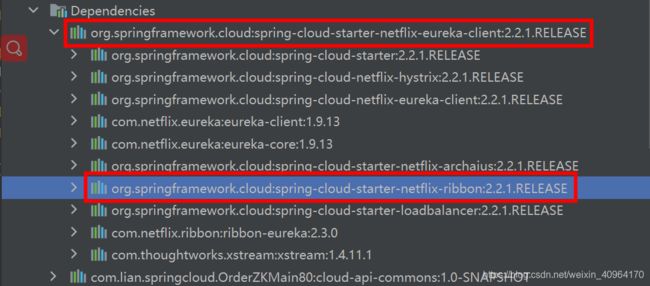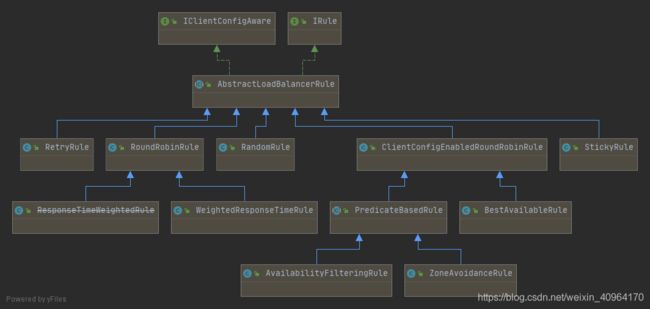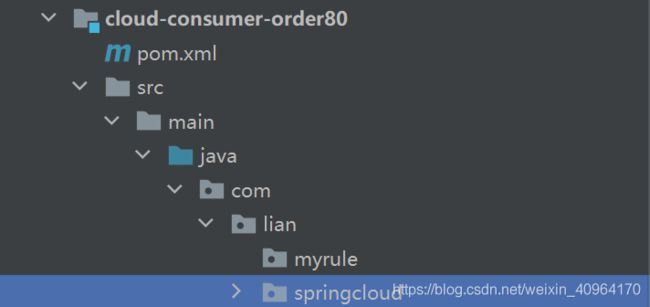SpringCloud【进阶】04:Ribbon实战教程
1、Ribbon入门介绍
Spring Cloud Ribbon是基于Netflix Ribbon实现的一套客户端负载均衡的工具。
Ribbon = 负载均衡(@LoadBalanced) + RestTemplate调用
主要功能是提供客户端的软件负载均衡算法和服务调用。Ribbon客户端组件提供一系列完善的配置项如连接超时,重试等。
简单的说,就是在配置文件中列出Load Balancer(简称LB)后面所有的机器,Ribbon会自动的帮助你基于某种规则(如简单轮询,随机连接等)去连接这些机器。我们很容易使用Ribbon实现自定义的负载均衡算法。
Ribbon目前也进入维护模式。
Ribbon未来可能被Spring Cloud LoadBalacer替代。
LB负载均衡(Load Balance)是什么
简单的说就是将用户的请求平摊的分配到多个服务上,从而达到系统的HA (高可用)。
常见的负载均衡有软件Nginx,LVS,硬件F5等。
Ribbon本地负载均衡客户端VS Nginx服务端负载均衡区别
Nginx是服务器负载均衡,客户端所有请求都会交给nginx,然后由nginx实现转发请求。即负载均衡是由服务端实现的。
Ribbon本地负载均衡,在调用微服务接口时候,会在注册中心上获取注册信息服务列表之后缓存到JVM本地,从而在本地实现RPC远程服务调用技术。
集中式LB
即在服务的消费方和提供方之间使用独立的LB设施(可以是硬件,如F5, 也可以是软件,如nginx),由该设施负责把访问请求通过某种策略转发至服务的提供方;
进程内LB
将LB逻辑集成到消费方,消费方从服务注册中心获知有哪些地址可用,然后自己再从这些地址中选择出一个合适的服务器。
Ribbon就属于进程内LB,它只是一个类库,集成于消费方进程,消费方通过它来获取到服务提供方的地址。
2、Ribbon的负载均衡和Rest调用
Ribbon是软负载均衡的客户端组件,它可以和其他所需请求的客户端结合使用,和Eureka结合只是其中的一个实例。
1、Ribbon在工作时分成两步
- 第一步先选择
EurekaServer,它优先选择在同一个区域内负载较少的server。 - 第二步再根据用户指定的策略,在从server取到的服务注册列表中选择一个地址。
其中Ribbon提供了多种策略:比如轮询、随机和根据响应时间加权。
2、POM说明
先前工程项目没有引入spring-cloud-starter-ribbon,但是也可以使用ribbon,这是因为spring-cloud-starter-netflix-eureka-client自带了spring-cloud-starter-ribbon引用

3、RestTemplate的使用
getForObject() 和 getForEntity() 区别:
getForObject():返回对象为响应体中数据转化成的对象,基本上可以理解为Json。
getForEntity():返回对象为ResponseEntity对象,包含了响应中的一些重要信息,比如响应头、响应状态码、响应体等。
package com.lian.springcloud.controller;
import com.lian.springcloud.entities.CommonResult;
import com.lian.springcloud.entities.Payment;
import lombok.extern.slf4j.Slf4j;
import org.springframework.beans.factory.annotation.Autowired;
import org.springframework.http.ResponseEntity;
import org.springframework.web.bind.annotation.*;
import org.springframework.web.client.RestTemplate;
@RestController
@Slf4j
public class OrderController {
@Autowired
RestTemplate restTemplate;
//public static final String PAYMENT_URL = "http://localhost:8001";
public static final String PAYMENT_URL = "http://CLOUD-PAYMENT-SERVICE";
@GetMapping("/consumer/payment/create")
public CommonResult<Payment> create(Payment payment){
return restTemplate.postForObject(PAYMENT_URL+"/payment/create",payment,CommonResult.class);
}
@GetMapping("/consumer/payment/get/{id}")
public CommonResult<Payment> getPayment(@PathVariable("id") Long id){
return restTemplate.getForObject(PAYMENT_URL+"/payment/get/"+id,CommonResult.class);
}
//案例演示 getForObject 和 getForEntity 区别
@GetMapping("/consumer/payment/getForEntity/{id}")
public CommonResult<Payment> getPayment2(@PathVariable("id") Long id){
ResponseEntity<CommonResult> entity = restTemplate.getForEntity(PAYMENT_URL + "/payment/get" + id, CommonResult.class);
if (entity.getStatusCode().is2xxSuccessful()){
return entity.getBody();
}else{
return new CommonResult<>(444,"操作失败");
}
}
}
3、Ribbon默认自带的负载规则
lRule:根据特定算法从服务列表中选取一个要访问的服务
package com.netflix.loadbalancer;
public interface IRule {
Server choose(Object var1);
void setLoadBalancer(ILoadBalancer var1);
ILoadBalancer getLoadBalancer();
}
- RoundRobinRule 轮询
- RandomRule 随机
- RetryRule 先按照RoundRobinRule的策略获取服务,如果获取服务失败则在指定时间内会进行重试,获取可用的服务
- WeightedResponseTimeRule 对RoundRobinRule的扩展,响应速度越快的实例选择权重越大,越容易被选择
- BestAvailableRule 会先过滤掉由于多次访问故障而处于断路器跳闸状态的服务,然后选择一个并发量最小的服务
- AvailabilityFilteringRule 先过滤掉故障实例,再选择并发较小的实例
- ZoneAvoidanceRule 默认规则,复合判断server所在区域的性能和server的可用性选择服务器
4、Ribbon负载规则替换
1、修改cloud-consumer-order80注意配置细节
官方文档明确给出了警告:
这个自定义配置类不能放在@ComponentScan所扫描的当前包下以及子包下
否则我们自定义的这个配置类就会被所有的Ribbon客户端所共享,达不到特殊化定制的目的了。
(也就是说不要将Ribbon配置类与主启动类同包)
2、新建package - com.lian.myrule
3、在com.lian.myrule下新建MySelfRule规则类
package com.lian.myrule;
import com.netflix.loadbalancer.IRule;
import com.netflix.loadbalancer.RandomRule;
import org.springframework.context.annotation.Bean;
import org.springframework.context.annotation.Configuration;
@Configuration
public class MySelfRule {
@Bean
public IRule myRule(){
return new RandomRule();
}
}
4、主启动类添加@RibbonClient
package com.lian.springcloud;
import com.lian.myrule.MySelfRule;
import org.springframework.boot.SpringApplication;
import org.springframework.boot.autoconfigure.SpringBootApplication;
import org.springframework.cloud.netflix.eureka.EnableEurekaClient;
import org.springframework.cloud.netflix.ribbon.RibbonClient;
@SpringBootApplication
@EnableEurekaClient //<--- eureka注册发现添加该标签
@RibbonClient(value = "CLOUD-PAYMENT-SERVICE",configuration = MySelfRule.class)
public class OrderMain80 {
public static void main(String[] args) {
SpringApplication.run(OrderMain80.class,args);
}
}
5、测试
开启eureka cloud-eureka-server7001
提供者cloud-provider-payment8001

提供者cloud-provider-payment8002

cloud-consumer-order80,配置了随机负载算法

5、Ribbon默认负载轮询算法原理
默认负载轮训算法: rest接口第几次请求数 % 服务器集群总数量 = 实际调用服务器位置下标,每次服务重启动后rest接口计数从1开始。
List
如:
- List [0] instances = 127.0.0.1:8002
- List [1] instances = 127.0.0.1:8001
8001+ 8002组合成为集群,它们共计2台机器,集群总数为2,按照轮询算法原理:
- 当总请求数为1时:1%2=1对应下标位置为1,则获得服务地址为127.0.0.1:8001
- 当总请求数位2时:2%2=О对应下标位置为0,则获得服务地址为127.0.0.1:8002
- 当总请求数位3时:3%2=1对应下标位置为1,则获得服务地址为127.0.0.1:8001
- 当总请求数位4时:4%2=О对应下标位置为0,则获得服务地址为127.0.0.1:8002
- 如此类推…
6、RoundRobinRule源码分析
juc知识点:CAS和自旋锁
package com.netflix.loadbalancer;
import com.netflix.client.config.IClientConfig;
import java.util.List;
import java.util.concurrent.atomic.AtomicInteger;
import org.slf4j.Logger;
import org.slf4j.LoggerFactory;
public class RoundRobinRule extends AbstractLoadBalancerRule {
private AtomicInteger nextServerCyclicCounter;
private static final boolean AVAILABLE_ONLY_SERVERS = true;
private static final boolean ALL_SERVERS = false;
private static Logger log = LoggerFactory.getLogger(RoundRobinRule.class);
public RoundRobinRule() {
this.nextServerCyclicCounter = new AtomicInteger(0);
}
public RoundRobinRule(ILoadBalancer lb) {
this();
this.setLoadBalancer(lb);
}
public Server choose(ILoadBalancer lb, Object key) {
if (lb == null) {
log.warn("no load balancer");
return null;
} else {
Server server = null;
int count = 0;
while(true) {
if (server == null && count++ < 10) {
List<Server> reachableServers = lb.getReachableServers();
List<Server> allServers = lb.getAllServers();
int upCount = reachableServers.size();
int serverCount = allServers.size();
if (upCount != 0 && serverCount != 0) {
int nextServerIndex = this.incrementAndGetModulo(serverCount);
server = (Server)allServers.get(nextServerIndex);
if (server == null) {
Thread.yield();
} else {
if (server.isAlive() && server.isReadyToServe()) {
return server;
}
server = null;
}
continue;
}
log.warn("No up servers available from load balancer: " + lb);
return null;
}
if (count >= 10) {
log.warn("No available alive servers after 10 tries from load balancer: " + lb);
}
return server;
}
}
}
private int incrementAndGetModulo(int modulo) {
int current;
int next;
do {
current = this.nextServerCyclicCounter.get();
next = (current + 1) % modulo;
} while(!this.nextServerCyclicCounter.compareAndSet(current, next));
return next;
}
public Server choose(Object key) {
return this.choose(this.getLoadBalancer(), key);
}
public void initWithNiwsConfig(IClientConfig clientConfig) {
}
}
7、Ribbon之手写轮询算法
1、7001/7002集群启动
2、8001/8002配置controller
添加轮询请求
package com.lian.springcloud.controller;
import com.lian.springcloud.entities.CommonResult;
import com.lian.springcloud.entities.Payment;
import com.lian.springcloud.service.PaymentService;
import lombok.extern.slf4j.Slf4j;
import org.springframework.beans.factory.annotation.Autowired;
import org.springframework.beans.factory.annotation.Value;
import org.springframework.cloud.client.ServiceInstance;
import org.springframework.cloud.client.discovery.DiscoveryClient;
import org.springframework.web.bind.annotation.*;
import javax.annotation.Resource;
import java.util.List;
/**
* @requestBody可以将请求体中的JSON字符串绑定到相应的bean上
*/
@RestController
@Slf4j
public class PaymentController {
@Resource
PaymentService paymentService;
@Autowired
DiscoveryClient discoveryClient;
//添加serverPort,目的做客户端的负载均衡
@Value("${server.port}")
private String serverPort;
@PostMapping(value = "/payment/create")
public CommonResult create(@RequestBody Payment payment){
int result = paymentService.create(payment);
log.info("*****插入结果:"+result);
if (result > 0){
return new CommonResult(200,"插入数据库成功,端口号serverPort是"+serverPort,result);
} else {
return new CommonResult(444,"插入数据库失败",null);
}
}
@GetMapping(value = "/payment/get/{id}")
public CommonResult<Payment> getPaymentById(@PathVariable("id") Long id){
Payment payment = paymentService.getPaymentById(id);
if (payment != null){
return new CommonResult(200,"查询成功,端口号serverport是"+serverPort,payment);
} else {
return new CommonResult(444,"查询失败,没有对应记录,查询id:"+id,null);
}
}
/**
* 测试服务发现
*/
@GetMapping(value = "/payment/discovery")
public Object discovery(){
List<String> services = discoveryClient.getServices();
for (String service : services) {
log.info("server"+service);
}
List<ServiceInstance> instances = discoveryClient.getInstances("CLOUD-PAYMENT-SERVICE");
for (ServiceInstance instance : instances) {
log.info(instance.getInstanceId()+"\t",
instance.getHost()+"\t",
instance.getPort()+"\t",
instance.getUri());
}
return this.discoveryClient;
}
//手写轮询算法测试
@GetMapping(value = "/payment/lb")
public String getPaymentLB() {
return serverPort;//返回服务接口
}
}
3、cloud-consumer-order80微服务改造
1、去除之前的ribbon注解
ApplicationContextConfig去掉注解@LoadBalanced
package com.lian.springcloud.config;
import org.springframework.cloud.client.loadbalancer.LoadBalanced;
import org.springframework.context.annotation.Bean;
import org.springframework.context.annotation.Configuration;
import org.springframework.web.client.RestTemplate;
@Configuration
public class ApplicationContextConfig {
@Bean
//@LoadBalanced //使用@LoadBalanced注解赋予RestTemplate负载均衡的能力
public RestTemplate getRestTemplate(){
return new RestTemplate();
}
}
主启动类OrderMain80去掉注解@RibbonClient
package com.lian.springcloud;
import com.lian.myrule.MySelfRule;
import org.springframework.boot.SpringApplication;
import org.springframework.boot.autoconfigure.SpringBootApplication;
import org.springframework.cloud.netflix.eureka.EnableEurekaClient;
import org.springframework.cloud.netflix.ribbon.RibbonClient;
@SpringBootApplication
@EnableEurekaClient //<--- eureka注册发现添加该标签
//@RibbonClient(value = "CLOUD-PAYMENT-SERVICE",configuration = MySelfRule.class)
public class OrderMain80 {
public static void main(String[] args) {
SpringApplication.run(OrderMain80.class,args);
}
}
2、创建LoadBalancer接口
package com.lian.springcloud.lb;
import org.springframework.cloud.client.ServiceInstance;
import java.util.List;
public interface LoadBalancer {
ServiceInstance instances(List<ServiceInstance> serviceInstances);
}
3、接口实现类MyLB
package com.lian.springcloud.lb;
import org.springframework.cloud.client.ServiceInstance;
import org.springframework.stereotype.Component;
import java.util.List;
import java.util.concurrent.atomic.AtomicInteger;
//放入spring容器中
@Component
public class MyLB implements LoadBalancer{
//原子类初始值设为0
private AtomicInteger atomicInteger = new AtomicInteger(0);
//执行的次数
public final int getAndIncrement(){
int current;
int next;
do {
//获取当前值是0
current = this.atomicInteger.get();
//三元运算符,如果当前值大于100就变为0,否则next等于当前值自增1
next = current > 100 ? 0 : current+1;
//用当前值和期望值对比,如果相等则更新值,取反是while为false,跳出循环打印next
}while (!this.atomicInteger.compareAndSet(current,next));
System.out.println("next访问次数是:"+next);
return next;
}
//负载均衡算法:rest接口第几次请求数 % 服务器集群总数量 = 实际调用服务器位置下标 ,每次服务重启动后rest接口计数从1开始。
@Override
public ServiceInstance instances(List<ServiceInstance> serviceInstances) {
//执行的次数和服务的总数量求余,得出下标值
int index = getAndIncrement() % serviceInstances.size();
//返回第几个服务
return serviceInstances.get(index);
}
}
4、控制层OrderController
package com.lian.springcloud.controller;
import com.lian.springcloud.entities.CommonResult;
import com.lian.springcloud.entities.Payment;
import com.lian.springcloud.lb.LoadBalancer;
import com.lian.springcloud.lb.MyLB;
import lombok.extern.slf4j.Slf4j;
import org.springframework.beans.factory.annotation.Autowired;
import org.springframework.cloud.client.ServiceInstance;
import org.springframework.cloud.client.discovery.DiscoveryClient;
import org.springframework.http.ResponseEntity;
import org.springframework.web.bind.annotation.*;
import org.springframework.web.client.RestTemplate;
import javax.annotation.Resource;
import java.net.URI;
import java.util.List;
@RestController
@Slf4j
public class OrderController {
@Autowired
RestTemplate restTemplate;
//引入自己写的轮询算法类
@Resource
LoadBalancer loadBalancer;
@Autowired
DiscoveryClient discoveryClient;
//public static final String PAYMENT_URL = "http://localhost:8001";
public static final String PAYMENT_URL = "http://CLOUD-PAYMENT-SERVICE";
@GetMapping("/consumer/payment/create")
public CommonResult<Payment> create(Payment payment){
return restTemplate.postForObject(PAYMENT_URL+"/payment/create",payment,CommonResult.class);
}
@GetMapping("/consumer/payment/get/{id}")
public CommonResult<Payment> getPayment(@PathVariable("id") Long id){
return restTemplate.getForObject(PAYMENT_URL+"/payment/get/"+id,CommonResult.class);
}
//案例演示 getForObject 和 getForEntity 区别
@GetMapping("/consumer/payment/getForEntity/{id}")
public CommonResult<Payment> getPayment2(@PathVariable("id") Long id){
ResponseEntity<CommonResult> entity = restTemplate.getForEntity(PAYMENT_URL + "/payment/get" + id, CommonResult.class);
if (entity.getStatusCode().is2xxSuccessful()){
return entity.getBody();
}else{
return new CommonResult<>(444,"操作失败");
}
}
//测试自己写的轮询算法
@GetMapping(value = "/consumer/payment/lb")
public String getPaymentLB(){
//服务发现获取指定服务下的所有实例
List<ServiceInstance> instances = discoveryClient.getInstances("CLOUD-PAYMENT-SERVICE");
if (instances == null || instances.size() < 0){
return null;
}
//调用MyLb类中的instance方法
ServiceInstance serviceInstance = loadBalancer.instances(instances);
URI uri = serviceInstance.getUri();
return restTemplate.getForObject(uri+"/payment/lb",String.class);
}
}






